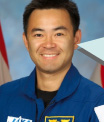|
|||||
| << September | November>> |
This is JAXA's Japanese astronaut primary activity report for October 2004.
In October, astronauts Furukawa, Hoshide, and Yamazaki continued with their Space Shuttle Mission Specialist training.
The astronauts continued with their T-38 flight training, which began
in September.
This month's training focused on instrument flying (flying
while relying solely on the aircraft's flight instruments), formation
flying, and skill check flight.
In the future, the astronauts will enhance
their skills through training on night flying and long-distance flying.
 |
The T-38 flight training started in September. The T-38 flight training is one of the core training regimens for NASA's astronauts. During the actual flight, I experienced less aircraft vibration and it was significantly quieter than I had expected. (Well, I did have my helmet on and that is probably why it was so quiet. Ha ha.) I have also flown faster than the speed of sound, but the flying altitude was too high to sense it. During acrobatic flying, I experienced 4Gs against my body, and I had the feeling that my internal organs were being pulled apart. During the flight, I had sweat covering my face. (Sounds like fun?) I must improve my navigation and piloting skills, so I will continue to do my best. |
 |
| Training in a zero-gravity environment generated by a KC-135 aircraft. |
 |
| T-38 flight training and zero-gravity training |
Zero-gravity training was conducted aboard a KC-135.
By
flying parabolic arcs, this aircraft is capable of simulating 20 seconds
of zero gravity.
This KC-135 is also quite well known since it was also
used in the filming of the movie Apollo 13.
At the end of October, this
KC-135 was to be retired from active service.
A C-9 will replace the
KC-135 for future zero-gravity training.
The astronauts visited Stennis Space Center, Michoud Operations, and
Marshall Space Flight Center. They observed test firing of the Space
Shuttle Main Engines (SSME) and the manufacturing of the External Tank
(ET).All of these facilities are doing their utmost for the Shuttle's
return to flight. Quite often, on the walls of these facilities, we
observed photos of the crew members who lost their lives in the Challenger
and Columbia accidents.We felt a keen awareness for safety and reliability at
these sites that support manned space flight activities.
|
|||||
On October 18, Expedition 9 crew member Mike Fincke handed over operations of the Canadarm2 to Expedition 10 crew member Leroy Chiao.Both astronauts operated the Canadarm2 during the handover process.
Providing ground support for Astronaut Fincke and Chiao, Astronaut
Wakata served as the CAPCOM at Mission Control Center in Houston. Astronaut
Wakata and Astronaut Chiao had previously flown together on STS-72
and on STS-92.Astronaut Wakata has a total of 13 manipulator operation
events in space, and he has also served as a robotics instructor astronaut.
Astronaut Wakata was assigned as the CAPCOM for this operation due
to his vast experience with the manipulators.
Astronaut Doi and Astronaut Wakata have been awarded the GEM (Go the Extra Mile) AWARD.The GEM AWARD is given in recognition of noteworthy NASA astronaut-related activities. Astronaut Doi received the GEM for his contribution on the ISS and Japanese Experiment Module "Kibo" activities based on his decision-making abilities and skills. Astronaut Wakata received the GEM for his contribution on ISS development and return-to-flight activities based on his excellent robotic operations and EVA skills.
| << September | November>> |

|